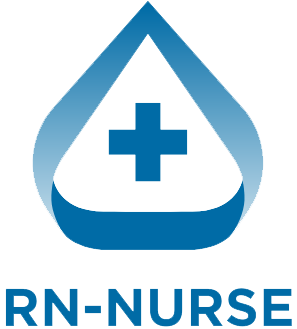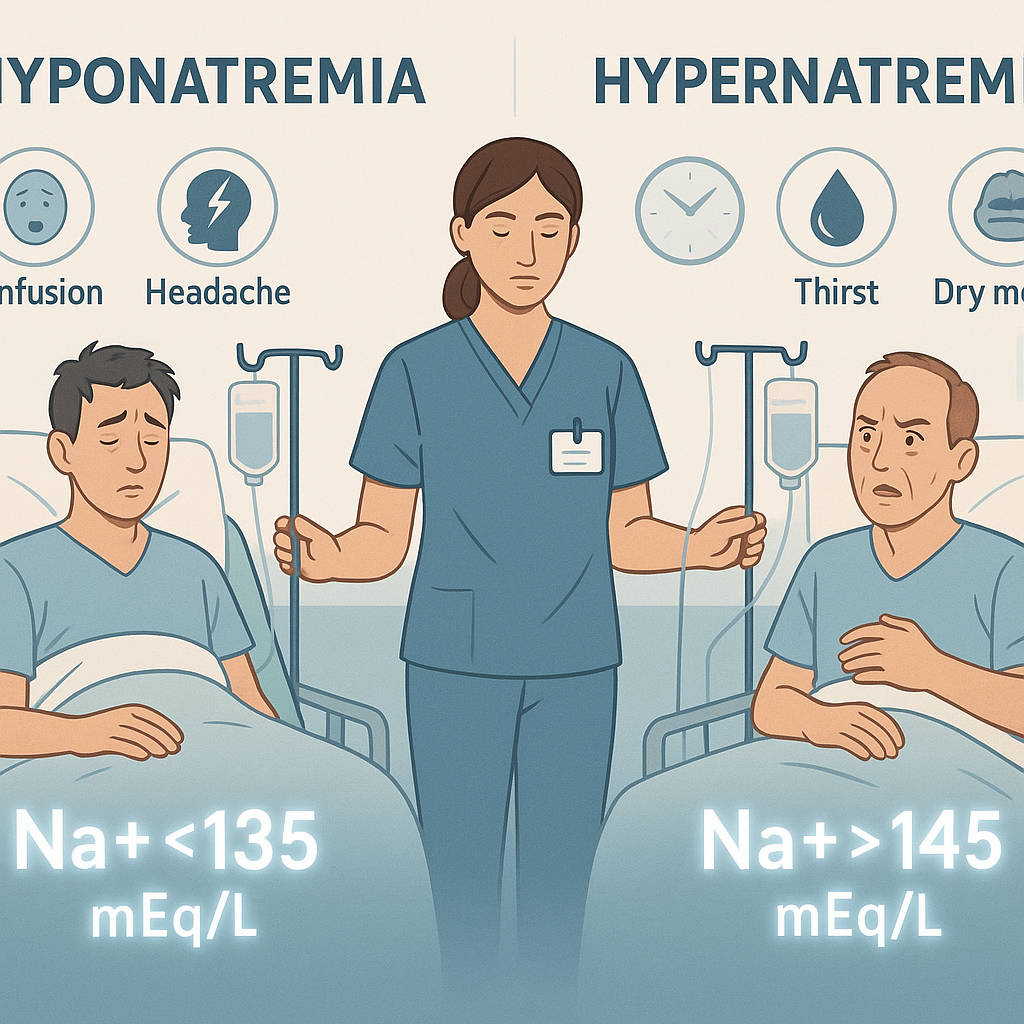Introduction
Sodium is a key mineral that helps the body keep the right balance of fluids. It also supports muscle movement and brain signals. When sodium levels go too low or too high, it can cause serious health problems. Two common sodium problems are hyponatremia and hypernatremia.
As a nurse, you need to know the signs of both conditions, what causes them, and how to help patients recover. In this guide, we break down both conditions using simple language and give clear nursing tips you can use right away.
What Is Hyponatremia?
Hyponatremia happens when the level of sodium in the blood drops below 135 mEq/L.
Signs of Hyponatremia:
- Headache
- Nausea or vomiting
- Weak muscles or cramps
- Confusion or feeling “foggy”
- Seizures (in severe cases)
- Feeling very tired or even coma
Common Causes:
- Drinking too much water (diluting sodium)
- Heart failure
- Kidney or liver disease
- SIADH (a hormone issue that keeps water in the body)
- Diuretics (water pills)
- Vomiting or diarrhea
Why It Matters:
Low sodium levels can make the brain swell. This is dangerous and can lead to seizures or death if not treated quickly.
What Is Hypernatremia?
Hypernatremia means the level of sodium in the blood is too high—above 145 mEq/L.
Signs of Hypernatremia:
- Feeling very thirsty
- Dry mouth or tongue
- Weakness or tiredness
- Confusion or restlessness
- Muscle twitches
- Seizures or coma (in severe cases)
Common Causes:
- Not drinking enough water
- Losing too much fluid (sweating, diarrhea, vomiting)
- Taking too much salt (or IV fluids with sodium)
- Diabetes insipidus
- Fever or burns
Why It Matters:
Too much sodium can pull water out of the brain cells, causing them to shrink. This leads to serious brain problems.
How Nurses Can Help: Hyponatremia
Here are some important steps nurses can take when a patient has low sodium:
- Check Mental Status Often
- Look for signs of confusion, tiredness, or changes in speech or alertness.
- Watch I&O (Intake and Output)
- Keep close records of how much the patient drinks and how much they urinate.
- Give Fluids as Ordered
- Some patients may need salty IV fluids like 3% saline. Others may need less water intake.
- Watch for Seizures
- Keep seizure pads on the bed and suction nearby for severe cases.
- Teach the Patient
- If caused by drinking too much water, teach patients to limit fluid intake.
How Nurses Can Help: Hypernatremia
When caring for patients with high sodium levels, here’s what you can do:
- Give the Right Fluids
- Doctors may order fluids like D5W or 0.45% NS. Give them slowly to avoid brain swelling.
- Encourage Oral Fluids
- If the patient can drink safely, offer water often.
- Check Vitals Often
- Watch for changes in blood pressure, heart rate, and breathing.
- Mouth Care
- Patients often have dry mouths. Use swabs or offer ice chips if allowed.
- Check Lab Values
- Monitor sodium, osmolality, and urine output closely.
Compare: Hyponatremia vs. Hypernatremia
FeatureHyponatremiaHypernatremiaSodium LevelLess than 135 mEq/LMore than 145 mEq/LCauseToo much water / sodium lossNot enough water / too much sodiumCommon SymptomsConfusion, headache, seizuresThirst, restlessness, dry mouthRiskBrain swellingBrain shrinkingMain TreatmentFluid restriction or sodium replacementSlow rehydration with IV fluids
Why This Is Important in Critical Care
Electrolyte problems like these are common in ICU, ER, and medical-surgical units. They can come on suddenly or happen over time.
A delay in recognizing the signs may lead to worse outcomes for patients. Nurses must act fast, stay alert, and work with the medical team to fix the issue quickly.
Tips for Nursing Students and New Nurses
- Know Your Normals: Always remember normal sodium ranges: 135–145 mEq/L
- Speak Up: If you notice changes in mental status or labs, alert the provider immediately.
- Use Mnemonics: To remember signs and treatment steps easily, use memory aids like “SALT LOSS” for hyponatremia or “FRIED” for hypernatremia symptoms.
SALT LOSS (Hyponatremia):
- Seizures
- Abdominal cramping
- Lethargy
- Tendon reflexes decreased
- Loss of urine and appetite
- Orthostatic hypotension
- Shallow respirations
- Spasms of muscles
FRIED (Hypernatremia):
- Fever (low grade), flushed skin
- Restless
- Increased fluid retention
- Edema (peripheral and pitting)
- Decreased urinary output, dry mouth
Final Thoughts
Understanding hyponatremia vs. hypernatremia is essential for keeping patients safe. These sodium problems affect the brain and body fast, so nurses must act quickly.
By learning the causes, recognizing early signs, and knowing how to respond, you can help patients recover faster and avoid serious complications.

